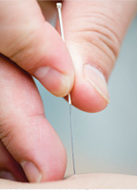Orthopaedic Trigger Point Dry Needling
Dry
Needling is a very successful medical treatment, which uses very thin
needles without any medication (a dry needle) to achieve its aims. Dry
Needling is used to treat pain and dysfunction caused by muscle
problems. Studies have also shown it to treat sinus trouble, headaches,
and nerve problems amongst a host of other ailments.
Dry needling is especially effective in those areas which are muscle
dense, e.g. gluteals and hips. Deep tissue treatment in these areas can
sometimes be uncomfortable, tender and can bruise the tissue due to the
pressure applied trying to reach the deeper layer of muscles. However,
with the dry needling the therapist can go straight to the area that
needs to be treated without causing bruising or exquisite tenderness
.The benefits of Dry Needling frequently include more than just relief
from a particular condition. Many people find that it can also lead to
increased energy levels, better appetite and sleep as well as an
enhanced sense of overall well being.
How does dry needling work?
Dry
Needling (also known as trigger point needling) is a scientifically
proven form of treatment to treat trigger nerve endings. The needle is
inserted into the skin and muscle directly at the myofascial trigger
point. A myofascial trigger point consists of multiple contraction
knots, which are related to production and maintenance of the pain
cycle. When the needle is inserted, very often a local twitch response
is experienced which is the first step in breaking the pain cycle..
After a dry needling treatment the area in the muscle which has been
treated feels much softer and relaxed and the person will feel looser. Research has shown that dry needling releases the chemicals which cause pain from the knotted muscle fibres.
Is Dry Needling similar to acupuncture?
There are many similarities and many differences between dry needling and acupuncture. Dry Needling
newer, more modern technique then acupunture. It is not Acupuncture. Acupunture is part of
the traditional Chinese medicine using principles such as energy flow as its direction for treatment,
whereas Dry Needling is strictly based on Western medicine principles and research using the anatomy
of the body especially the muscles as its corner stone.
Frequently Asked Questions
Is dry-needling safe?
Yes,
studies have shown that it is one of the safest forms of medical
intervention known. It is far safer than using drugs. Only sterile
disposable needles are used.
What can Dry Needling help?
Dry
needling can be used for a variety of musculoskeletal problems. Muscles
are thought to be a primary contributing factor to the symptoms.
Conditions which respond to dry needling include, but are not limited
to:
· Muscle Spasms
· Headaches
· Frozen Shoulder
· Tennis elbow
· Carpal tunnel syndrome
· Golfer's elbow
· Fibromyalgia
· Sciatic Pain
· Buttock pain
· Leg pain
· Hamstring strains
· Shin splints
· Hip Pain
· Knee Pain
· Repetitive Strain Injuries
· Jaw Pain
Are there any reasons why I should not have dry-needling?
There
are very few. If you are taking anticoagulant medicines such as
warfarin, or if you have skin infections near the trigger points, then
needling should not be used. Obesity and pregnancy are also
contraindications to dry needling.
Where do you find Trigger Points and Myofascial Pain?
Just
about anywhere! In the muscles across the shoulders and in the neck
they are a common cause of persistent headache. In the spine they cause
back pain and in the buttock muscles cause hip and leg pain. Around the
knee they cause pain referred to the knee and around the elbow they
often cause pain similar to tennis elbow. They are a very common cause
of shoulder pain.
Are the needles sterile? Yes, we only use sterile disposable needles.
Does dry-needling hurt?
The needle is so sharp and thin you will not feel it enter your skin.
The twitch or Local Twitch Response elicits a very brief (less than a
second) painful response. Some patients describe this as a little
electrical shock, others feel it more like a cramping sensation. The
therapeutic response occurs with the elicitation of the Local Twitch
Responses and that is the desirable reaction.
The amount of pain felt seems to vary from person to person, but almost
everyone agrees the relief of pain from the treatment is well worth the
"investment".
What side effect can I expect after treatment ?
Most
patients report muscle soreness after the procedure over the area
treated and into the areas of the referred symptoms. Typically, the
soreness lasts between a few hours and two days. Some people may be very
tired after the treatment.
What should I do after Dry Needling?
Our
recommendations vary depending on the soreness you have on the
individual response to the treatment. You might find Icing the area will
help or by stretching the treated muscle as much as possible, 10 seconds by 3 at a time.
How long does it take for a procedure to work?
Typically, it takes several visits for a positive reaction to take place. Again, we are trying to cause
mechanical and biomechanical changes without any pharmacological means.
Therefore, we are looking for a cumulative response to achieve a
certain threshold after which the pain cycle is disturbed.
Why is my doctor not familiar with dry needling ?
Dry
Needling is a relatively new method for treating myo-fascial pain and
not everyone is already aware of the effective modality.
How does dry needling fit into Physical therapy ?
Dry Needling is a new and effective way of treating pain. As it is based on the anatomy of the muscles
of the body, dry needling synchronizes with physical therapy treatment perfectly.
For more information please contact Darren at our Galway Clinic:
Mob: 086 1957378 | Email: darren@sportsinjurytherapy.ie













